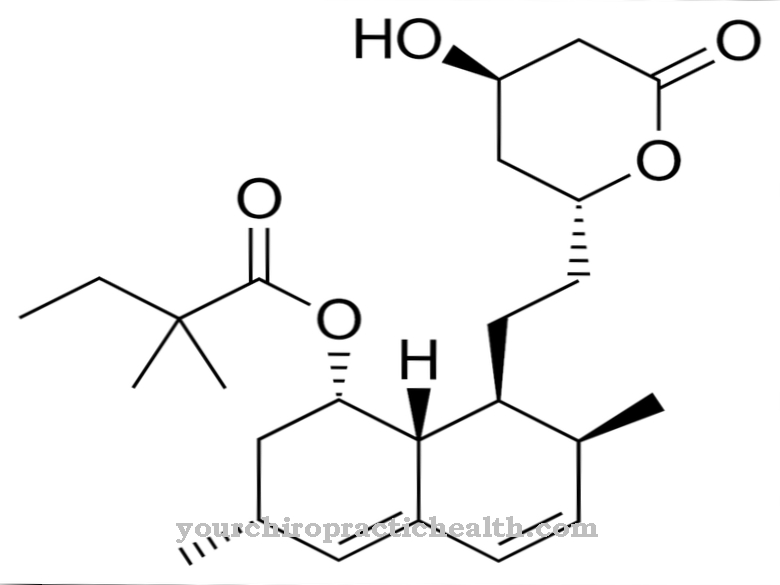Chloroquine is a drug that is used for the treatment and prophylaxis of malaria and is also used for the treatment of rheumatic inflammation. However, malaria pathogens have developed resistance to chloroquine in many regions, so that the use of the medicinal substance against malaria is limited to certain regions.
The ingestion of chloroquine can cause undesirable side effects, which mainly affect the gastrointestinal tract and in rarer cases also lead to eye diseases of the retina and cornea.
What is chloroquine?
Chloroquine is a drug that is composed of stereoisomers (enantiomers) and is similar to quinine. The chemical formula (C18H26ClN3) shows that it is a chemical compound that consists almost exclusively of carbon and hydrogen, but with a single added chlorine atom and three nitrogen atoms. One of the three N atoms forms a corner point of an aromatic six-membered ring, while another N atom is connected to two terminal methyl groups (-CH3). The third N atom is part of the hydrogen bond between the two aromatic six-membered rings and the rest of the compound.
Because chloroquine is insoluble in water, the water-soluble salts chloroquine diphosphate or chloroquine sulfate are usually used as medicinal substances. The salts also have the advantage that they are air-stable.
In Switzerland, drugs whose active ingredient consists exclusively of chloroquine (monopreparations) are known under the names Chlorochin® and Nivaquine®, in Germany and Austria under Resochin®. Another preparation, Weimerquin®, is also approved in Germany.
Pharmacological effect
The main effect of chloroquine is to inhibit the crystallization of hemozoin, which is produced when the heme, the red blood pigment, is broken down. Plasmodia, the causative agent of malaria, occupy the red blood cells (erythrocytes) at a certain stage and with their enzymes break down the hemoglobin they contain. They use the resulting protein fragments in the form of peptides, polypeptides and amino acids of hemoglobin for their own protein synthesis.
The hemozoin that is also released from the split heme has a toxic effect on the plasmodia. For their own protection, the unicellular pathogens use the enzyme hempolymerase, which leads to the crystallization of the hemozoin, rendering it harmless. Chloroquine inhibits this enzyme and thus prevents the crystallization of the hemozoin, which ideally leads to the destruction of the plasmodia.
The effects of temporary flooding of the body with hemozoin and simultaneous infection with plasmodia have not yet been adequately researched. The worldwide use of chloroquine-based drugs for malaria therapy and prophylaxis, however, has led to the development of resistance among the pathogens.
In addition to the specific effect of the drug, there are also anti-inflammatory properties, which are probably based on the inhibition of certain interleukins and other messenger substances.
However, it is not sufficiently known what the side effects of the drug are based on, which can lead to complaints, especially in the gastrointestinal tract. In many cases, deposits of the medicinal substance chloroquine in the retina and cornea of the eyes have been observed, so that in rare cases retinopathies or corneal opacity can occur.
Medical application & use
Medicines containing chloroquine, such as Resochin, are mainly used for the treatment and prophylaxis of malaria. Until resistance developed, the active ingredient chloroquine was primarily used to combat tropica malaria, which is triggered by the pathogen Plasmodium falciparum. Malaria tropica is considered to be the most dangerous of the four major malaria species. It leads to attacks of fever at irregular intervals and is therefore often not diagnosed as malaria early on.
In the 1950s to the 1970s, monopreparations with chloroquine as the active ingredient embodied the standard agents for malaria prophylaxis and for the treatment of malaria. The high half-life of the active ingredient of around 60 days guarantees an effect even after the drug has been discontinued.
In order to establish effective malaria protection in areas where no resistance to chloroquine has been observed, it is necessary to start taking the tablets one week before the planned trip to an endemic area and take them up to four weeks after leaving the malaria area To maintain the territory.
In addition to the main area of application of chloroquine for malaria prophylaxis, the drug is also used to treat rheumatoid arthritis due to its anti-inflammatory properties.
In rare cases, chloroquine is also used for the accompanying treatment of lupus erythematosus to contain inflammatory processes. Lupus erythematosus is a systemic autoimmune disease that progresses in relapses and usually requires both anti-inflammatory measures and long-term immunosuppression in order to suppress the progression of the disease as much as possible and to alleviate the symptoms as much as possible.
Risks & side effects
A number of short-term or long-term side effects can occur after taking medication containing chloroquine. The most common symptoms associated with chloroquine affect the gastrointestinal tract. The complaints found range from loss of appetite to nausea with vomiting to diarrhea. The symptoms can occur temporarily, until you get used to the drug, or last longer, so that an alternative option for chloroquine has to be found.
Deposits and deposits in the cornea and retina of the eyes can occur, especially with long-term use of chloroquine, because of permanent residence in endemic malarial areas or when the drug is taken in conjunction with the therapy of lupus erythematosus, for example. The deposits can lead to clouding of the cornea with impaired vision or to retinopathy, a retinal disease. With regular eye checks or after the first appearance of symptoms and an objective diagnosis, it is possible to counteract serious eye diseases by discontinuing the active ingredient.



























